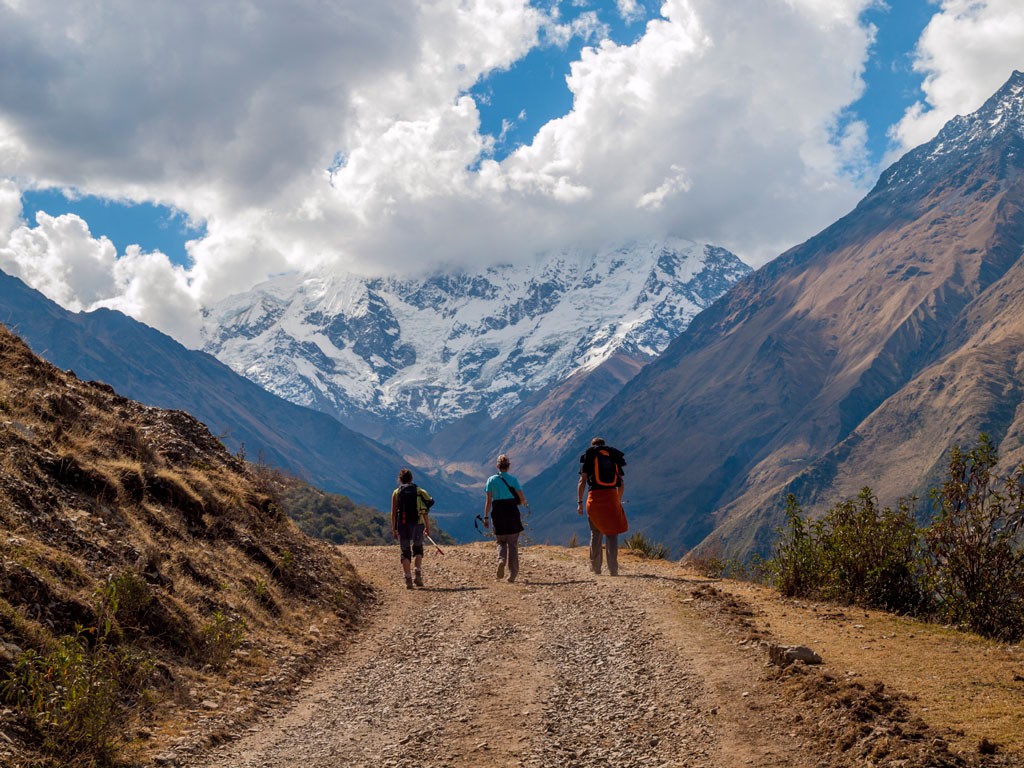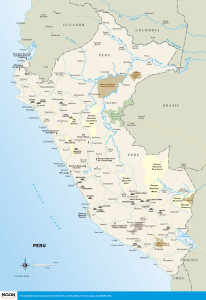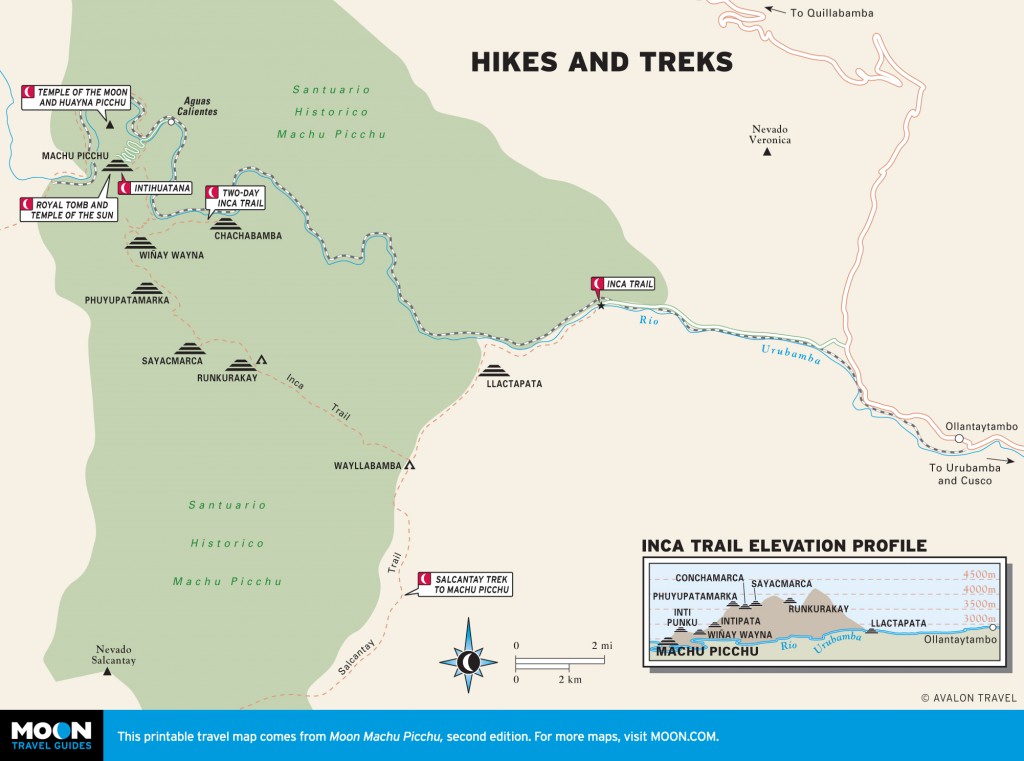
Trekking the Salcantay Route, a popular alternative to the Inca Trail. Photo © holgs/iStock.

Peru
Peru is one of the world’s top trekking destinations, and the Inca Trail is Peru’s number one trek. Beginning in the high Andes with views of sparkling glaciers, the Inca Trail passes a dozen major Inca ruins before plunging into the cloud forest toward Machu Picchu. Apart from the Inca Trail, there are dozens of incredible treks in Peru’s Andes, which are every bit as spectacular as treks in the European Alps, Alaska Range, or the Himalaya. Outside the Cusco area, the other main trekking area in Peru is the Cordillera Blanca, the second-highest mountain range in the world.The Inca Trail is the only trek in Peru where all trekkers must hike with a licensed guide and where there is a limit of 500 people per day. These recent rules are a result of the Inca Trail’s popularity and the impact that tens of thousands of trekkers have had on its stone trail and the surrounding ecosystem. For the Inca Trail, your only option is to sign up with a licensed agency—and sign up early, as the Inca Trail fills up six months or more ahead of time.
As a result of these new rules, Inca Trail prices have increased from as low as US$90 in 2000 to a minimum of US$450 today. Local agencies no longer offer last-minute Inca Trail trips; bookings are now done almost exclusively online as the trail’s licensed operators have to confirm all reservations several months in advance. Check the official departure availability. If a date you want is already booked, it’s still worth checking with agencies, as they often have cancellations.
Any other trek in Peru, including the Salcantay alternative route to Machu Picchu, has a couple of planning options. The easiest, and most expensive, is to sign up with a reputable agency and let it take care of all the details. But you can also custom-design a trip and then hire an agency to take care of logistics such as transport, food, lodging, porters, cooks, and certified guides. If you can find a reliable trekking or climbing guide, available for US$80-110 per day, he or she can organize all these details for you for an extra fee. Or you can do it all on your own, which is complicated to negotiate properly but possible if you speak Spanish and are experienced at trekking.

The traditional trekking season in Peru is May- August, but the best weather is June and July. Avoid the last week in July, when Peru’s hotels are often booked solid for the Fiestas Patrias celebration around July 28. On the Inca Trail, you will encounter fewer people during the months of April, May, September, and October. These “shoulder months” are the best times to trek in Peru, as they are outside of the rainiest months (November-March) and also the busiest tourist months (June-August). April and May, and even March if you don’t mind an occasional rain storm, are especially scenic as the rainy season has just ended and the highlands are lush and green.
The motto “you get what you pay for” is especially true when it comes to hiring a trekking agency or guide. Go with an established, well-recommended agency. If you skimp on an agency, you can be guaranteed the agency will either skimp on you (poor food, no bathroom tent), the porters (low wages, no health care), or the environment (pit latrines, no regard for Leave No Trace principles).
Plan for at least 3-4 days to acclimatize before heading out on a trek anywhere in Andean Peru. The Inca Trail has two passes of approximately 4,000 meters, and you will tackle these far better if you are physically ready.
Acclimatize by sleeping low and hiking high. A great way to acclimatize in the Cusco area is to spend your first few days in the Sacred Valley and then hike up out of valley floor in places like Pisac, Urubamba, and Ollantaytambo.
Porters will expect you to pay their wages the day that they return to the main town, usually the day after the end of your trek. This means that for a four-day trek, you will pay the porter five days of wages.
Groups usually hire a cook, too. Peru’s cooks pack in fruit, vegetables, sacks of rice, and often a live chicken or two. Pay the people you hire fairly and treat them with respect. You are their employer, so you are ultimately responsible for their health and safety. These are some standard daily wages: US$10 for a porter and US$8 for every mule, US$15 for camp guardian, US$25 for a porter, and US$25-30 for a cook. Also, you are expected to provide shelter and food for your cook and porters.
If you are on your own, you will have to negotiate the entry and grazing fees that Andean communities increasingly charge trekking groups that pass through their lands. The fees change rapidly and, in general, are relatively minor. Grazing fees are generally around US$2-5 per horse. Enquire with an agency about fees ahead of time.
The best place to get maps is the South American Explorers Club in Cusco (Atocsaycuchi 670, tel. 084/24-5484) or in the Miraflores neighborhood of Lima (Piura 135, tel.084/445-3306).
Most people who are trekking or climbing on their own bring all their own gear, but high-quality equipment can be rented for affordable prices in Cusco and Huaraz. Email agencies ahead of time for reservations and prices.
Peru’s tropical sun is intense, so bring strong sunscreen, a sun hat, sunglasses with UV protection, and a long-sleeved shirt. Most trekkers use trekking poles for descending the scree slopes and steep trails. The weather is cold, but extreme storms are rare in the dry months from May to September. Bringing plenty of layers, including waterproof ones, is essential. On most Peru treks, sleeping bags rated for 0°F and thermal long underwear or fleece pants are fine.
Pretty much all supplies, with the exception of freeze-dried food, are available in markets in Cusco. You’ll find pasta, powdered soup, cheese, powdered milk, beef jerky, dried fruit, and more. White gas (bencina blanca) is sold at hardware stores along Calle Plateros in Cusco and at numerous places in Huaraz and Caraz. Get a shop recommendation from an agency or gear store to ensure you find the highest quality gas, and fire up your stove before you go to make sure everything works. Remember that airlines sometimes reject travelers with camp stoves and fuel bottles that have been previously used. It’s best to travel with a new stove and bottles, if at all possible.
While the vast majority of trekkers to the Cusco and Huaraz areas never encounter any safety threats, the more popular trekking areas have seen an increase in theft. If you leave your camp for a day hike, make sure to leave a camp guardian, such as a porter behind. Entire camps of tents have been stolen in the Cordillera Blanca while teams were on the mountain. Minimize the impact by bringing the minimum of valuables and only enough cash for the duration of your trek.
The main hazards of trekking in Peru, however, are straightforward: sun, altitude, and cold. If you protect yourself from the sun, acclimatize properly, and have the right gear, you will have a great time.
Excerpted from the Second Edition of Moon Machu Picchu.